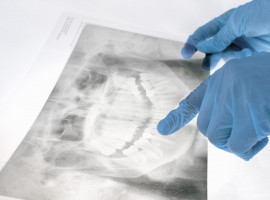OMS Faces Sanctions After Sedation of High-Risk Patient
Case Study
Marc Leffler, DDS, Esq.
October 30, 2023
Reading time: 8 minutes

To make an informed decision about the safety of sedation for each patient, it is crucial for oral and maxillofacial surgeons to consider a patient’s full medical history and all the possible complications that could occur when they are put under. In this case study, an OMS inappropriately sedates a high-risk patient, leading to sanctions against the OMS.
Key Concepts
- Patient selection for sedation
- Risks associated with in-office sedation
- Patient safety during procedures
Underlying Facts
Dr. U was an oral and maxillofacial surgeon, very new to practice, as a solo practitioner in a suburb of a large city. Based upon his training and experience, as well as his office set-up, he was approved by the state’s licensing authorities to deliver the full range of out-patient sedation and anesthesia modalities.
N was a 71-year-old female patient who had been speaking to her general dentist for a few years about the potential for replacing her double-distal-extension mandibular partial denture, because she was dissatisfied with its retention and function. She expressed her anxieties about having implants placed, upon which a fixed prosthesis would be fabricated, so the general dentist referred N to Dr. U to determine whether she was a suitable patient for these procedures under sedation.
Medically, N was obese, at 5’4″ tall and weighing 191 pounds (a BMI of 32.8), and she had COPD from years of smoking which she had since given up, and obstructive sleep apnea (OSA) for which she regularly used a CPAP machine. As a precaution, Dr. U sought and obtained medical clearance for the implant surgery under IV sedation from N’s primary care physician, so he felt confident in proceeding as planned.
On the date of surgery to place 6 implants in the mandible, N was NPO for more than 8 hours and was accompanied by her adult son. Dr. U placed a nasal mask on N, providing a 60%/40% N2O/O2 flow; this was followed by the delivery of the first dose of Midazolam intravenously, which was supplemented and titrated as necessary over the next 2 ½ hours. Local anesthesia was injected after N became relaxed and somnolent. Monitors said to Dr. U that his patient was stable throughout.
Upon completion of the procedure, N unsteadily walked to the office recovery area, assisted by both a dental assistant and N’s son. After approximately 30 minutes, N appeared as still being “out of it”, so Dr. U gave her a dose of Flumazenil to reverse the effects of the Midazolam. N steadily became more alert, so she was discharged home; N’s son took her home and stayed with his mother for the rest of the day. About 4 hours later, N’s son noticed that his mother seemed to be slipping backward into a sleepier state, and this process continued to the point that it became difficult to arouse her, with an irregular snoring pattern happening. The son contacted EMS; upon EMS arrival, N’s SpO2 (oxygen saturation) measured 81% and N’s depressed mental status and breathing pattern did not improve. With the approval of the ED physician whom EMS had contacted, N was intubated and given supplemental oxygen while being transported to the hospital, where she remained for the next 8 days until she was able to breathe on her own and maintain an SpO2 of 94-96%. According to N, her son, and N’s friends, she was never able to return to the usual daily activities that she enjoyed prior to the implant procedure.
Legal Steps Taken
Although N’s son met with several attorneys on his mother’s behalf, he was unable to find any who would proceed with a malpractice action against Dr. U, for the general reason that it would be difficult to objectively demonstrate compensable damages. But the son was very upset by what he saw in his mother’s ability loss, so he filed a Board complaint against Dr. U.
Upon receipt of the complaint, Dr. U reached out to his malpractice carrier, following which counsel was assigned by the carrier to represent him before the Board. All records were timely provided to the Board, and Dr. U appeared, with his attorney, for several interviews before Board members and a dental anesthesiologist “expert”. Dr. U’s testimony relied heavily on the facts that he had obtained pre-sedation medical clearance from N’s physician, as well as his background in treating patients similar to N, so he felt fully justified in his patient selection, and that he had kept N in his office until she was clearly in a state that was stable enough for discharge.
At the conclusion of its investigation, the Board issued a report in which it found a number of care deficiencies on the part of Dr. U, and levied sanctions against him, namely a fine, a 2-month suspension from practice, and revocation of his sedation permit. The major findings of the Board, which it detailed in its report, were that Dr. U had inappropriately delivered in-office sedation to a patient who was not a suitable candidate, and for whom he did not take proper precautions during the post-sedation period; the Board viewed the obtained medical clearance as essentially irrelevant to the issues, because the ultimate decisions about treatment ultimately lie with the treating practitioner.
Citing to an attached set of findings by the Board’s expert, the Board first determined that N had been misclassified by Dr. U as an ASA (American Society of Anesthesiologists) Class II patient, when she was actually a Class III; the Board pointed to the fact that the expert’s opinions stated that patients with greater than a Class II designation ought not to be sedated in an office setting unless a medical or dental anesthesiologist, or an OMS, was present to manage the anesthesia aspects of care alone, rather than the operating surgeon also performing the sedation care. The Board determined that, while N’s obesity status placed her as an ASA II, her OSA requiring CPAP use meant that this disease was “severe”, placing her as an ASA III, and her COPD, alone, categorized N as a Class III. All told, N was an ASA Class III, making her an inappropriate choice for in-office sedation unless Dr. U, as the operating surgeon, had delegated that aspect of treatment to another qualified practitioner, according to the Board.
Furthermore, the Board found that Dr. U had failed to consider and take into account the relative half-lives of the drugs he employed, Midazolam and Flumazenil. The Board’s expert detailed that Midazolam’s half-life was measured on the order of 1.5-2.5 hours, while its reversal agent, Flumazenil, had a half-life of approximately 30 minutes; so, estimating that 4-5 half-lives are necessary for “clinical elimination”, Dr. U failed to take into account that the sedative agent would stay in N’s system for far longer than its reversal agent, leading to a revived level of sedation – with decreased respiration – once the reversal drug had effectively dissipated.
Takeaways
As many parents have said to their newly licensed teenage children, “just because you can drive doesn’t mean you really know how to drive”. The same principle holds here, specifically in the sedation realm, but also regarding dental and oral surgery practice generally. It is, of course, necessary for practitioners to obtain all required credentials in their jurisdictions of practice, but the abilities to perform the range of tasks needed for safe practice do not instantaneously develop on the day a degree or certificate is conferred; rather those abilities will mature with time, so it is the obligation of every practitioner to practice at levels commensurate with their skills at the time, in order to properly protect their patients. While OMSs are extremely well-trained specialists, there seems no reason to see these concepts differently as to them.
This case study is not meant to promote the specific opinions of the involved Board or its expert, but the study’s purpose is to demonstrate some of the approaches employed in the state’s oversight of its licensed professionals. Unlike courts and juries sitting on dental malpractice cases, in which they must determine whether a plaintiff has demonstrated that negligence has directly caused damages, Boards look simply at the actions of professionals, regardless of the extent or even existence of damages, to determine whether those actions fall within the standards by which their mandates provide. Another stark difference between Board matters and trials is that, while trials have a “battle of experts” as an integral part of the process, so as to allow for opposing views to factor into jury determinations, Board matters often do not allow for such defenses, so decisions might be made by Board members solely based upon the position of their own chosen expert.
The process of obtaining pre-treatment medical clearance played a significant role in this case, but that is, by no means, an approach limited to dental treatment under sedation or general anesthesia. OMSs, and other dental professionals as well, are often confronted with patients suffering from numerous medical conditions, and it is left to those practitioners to determine whether it is safe to proceed based upon the information provided by the patient and taking into account their own knowledge and experience, as compared with seeking a medical opinion before going forward. That is a personal determination, always keeping the patient’s best interests in mind. But even when medical clearance is provided by a physician, it is the oral surgery/dental provider who bears the ultimate responsibility for the patient’s welfare. So, while a medical clearance is a valuable, and sometimes necessary, procedural step, it is best viewed as one of many factors to consider as treatment decisions are made.
Perhaps the most important concept from this case is the need for every practitioner to be fully familiar with every drug employed, every potential interaction, every procedure performed, and every realistic side effect. That is precisely what makes a professional. If in doubt, it might well be what is best for the patient to defer or refer, either to a different provider or a different environment of treatment.
Note that this case presentation includes circumstances from several different closed cases, in order to demonstrate certain legal and risk management principles, and that identifying facts and personal characteristics were modified to protect identities. The content within is not the original work of MedPro Group but has been published with consent of the author. Nothing contained in this article should be construed as legal, medical, or dental advice. Because the facts applicable to your situation may vary, or the laws applicable in your jurisdiction may differ, please contact your personal or business attorney or other professional advisors if you have any questions related to your legal or medical obligations or rights, state or federal laws, contract interpretation, or other legal questions.
Additional Claims content

Loss of Taste After Procedure Leads to Lawsuit Against OMS
Claims
Informed consent is one of the most important aspects of practicing oral and maxillofacial surgery. When performing procedures, ensuring through verbal agreement and documentation that a patient understands all possible negative outcomes is the best way to protect yourself against claims of malpractice. In this case study, an OMS’s informed consent documentation becomes key when she is sued over a patient’s loss of taste after a procedure.

Numbering System Miscommunication Leads to Extraction Mistake
Claims
In oral and maxillofacial surgery practices, there are a variety of numbering systems that are used to identify teeth, which can lead to miscommunication and mistakes. In this case study, an orthodontist refers a patient to an OMS for a tooth extraction. Upon receipt of the referral, there is a miscommunication with the orthodontist’s staff and the OMS mistakenly extracts the incorrect tooth.

Inadequate Informed Consent Leads to Legal Action Against OMS
Claims
In oral and maxillofacial surgery, informed consent is crucial to ensure patients are aware of all the potential risks and outcomes of undergoing treatment. In this case study, an OMS fails to properly inform their patient about all the possible negative outcomes associated with implants, and when the patient’s implants eventually fail, the OMS is sued for malpractice.
This document does not constitute legal or medical advice and should not be construed as rules or establishing a standard of care. Because the facts applicable to your situation may vary, or the laws applicable in your jurisdiction may differ, please contact your attorney or other professional advisors if you have any questions related to your legal or medical obligations or rights, state or federal laws, contract interpretation, or other legal questions.
MedPro Group is the marketing name used to refer to the insurance operations of The Medical Protective Company, Princeton Insurance Company, PLICO, Inc. and MedPro RRG Risk Retention Group. All insurance products are underwritten and administered by these and other Berkshire Hathaway affiliates, including National Fire & Marine Insurance Company. Product availability is based upon business and/or regulatory approval and/or may differ among companies.
© MedPro Group Inc. All rights reserved.